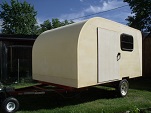any problems with thermal expansion/contraction of foam?
Moderator: eaglesdare
17 posts
• Page 1 of 2 • 1, 2
any problems with thermal expansion/contraction of foam?
Hello,
I was reviewing some information about different types of foam panels, and I ran across a publication by DuPont. Of course, they were interested in selling a vapor barrier product (Tyvek). The gist of the article is that XPS and EPS not only pass water vapor, but more importantly they show dimensional instability of 1-4%, e.g. a 48x96 panel may shrink to 47x94 in cold temperatures assuming a 2% shrinkage, or it may expand and buckle at high ambient temperatures. Here in SE Michigan, the temp can vary from about -15F to 95F from January to July.
http://www.dupont.com/content/dam/asset ... K25107.pdf
So, has anybody seen expansion and contraction 'in real life', with unhappy consequences?
I was reviewing some information about different types of foam panels, and I ran across a publication by DuPont. Of course, they were interested in selling a vapor barrier product (Tyvek). The gist of the article is that XPS and EPS not only pass water vapor, but more importantly they show dimensional instability of 1-4%, e.g. a 48x96 panel may shrink to 47x94 in cold temperatures assuming a 2% shrinkage, or it may expand and buckle at high ambient temperatures. Here in SE Michigan, the temp can vary from about -15F to 95F from January to July.
http://www.dupont.com/content/dam/asset ... K25107.pdf
So, has anybody seen expansion and contraction 'in real life', with unhappy consequences?
Curator
Museum of Unfinished Projects
Museum of Unfinished Projects
- Bob Hammond
- Teardrop Master
- Posts: 225
- Joined: Wed Feb 10, 2010 12:06 pm
- Location: Michigan
Re: any problems with thermal expansion/contraction of foam?
I have notice some expansion/contraction issues, but nothing that is a serious concern for me yet.
George.
Gorrilla Glue, Great Stuff and Gripper. The three G's of foamie construction.
My build viewtopic.php?t=54099
Working with flashing for foamie construction viewtopic.php?f=55&t=60303
Making a hot wire http://tnttt.com/viewtopic.php?f=55&t=55323
Gorrilla Glue, Great Stuff and Gripper. The three G's of foamie construction.
My build viewtopic.php?t=54099
Working with flashing for foamie construction viewtopic.php?f=55&t=60303
Making a hot wire http://tnttt.com/viewtopic.php?f=55&t=55323
-

ghcoe - 1000 Club

- Posts: 1982
- Joined: Fri Dec 11, 2009 11:20 pm
- Location: SW Idaho
 On a Foamie , There is also another factor of “expansion” whereby small dents are “healed" by the further expansion of the compressed areas.... it’s actually quite favorable ...
On a Foamie , There is also another factor of “expansion” whereby small dents are “healed" by the further expansion of the compressed areas.... it’s actually quite favorable ... 


 into the grid spaces. The ambient temperature will be 88-93F.
into the grid spaces. The ambient temperature will be 88-93F.
 That would be a pickle eh ?
That would be a pickle eh ? 